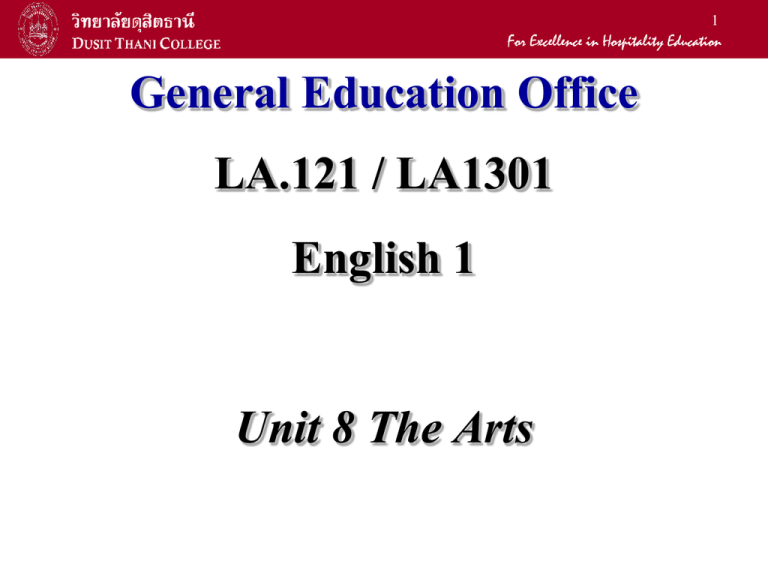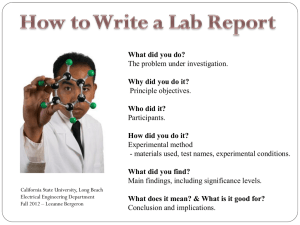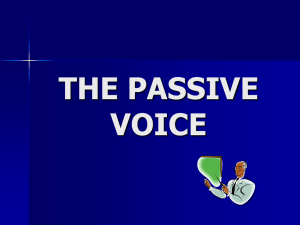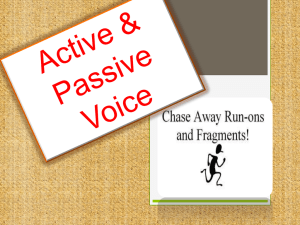Passive Voice
advertisement

1 General Education Office LA.121 / LA1301 English 1 Unit 8 The Arts 2 Objectives After this unit you will be able to: • Recommend a museum • Ask about and describe objects • Discuss your favourite artist 3 Kinds of Arts Drawing Pottery Jewelry Fashion Photography Read and listen. Then listen again and repeat. Sculpture Painting 4 Photo story C) Read and listen to a conversation at an art show. D) Focus on language Find and underlined expression in the Photo story to match each of the following explanations. 1) I didn’t know…. 2) I don’t really like…. 3) Everyone has a different opinion 4) I have some information that may surprise you. 5) I’m really surprised. 6) You can’t really know someone just by looking at him or her. 7) In my opinion it’s….. 5 Passive Voice The active voice focuses on the WHO does an ACTION. The passive voice focuses on the OBJECT that the ACTION affects. Active voice: Picasso painted Guernica in 1937. ( focus on Picasso) Passive voice: Guernica was painted by Picasso in 1937. (focus on Painting) Form passive voice with verb “to be” and past participle (V3) of a verb. Simple present tense: These vases are Present perfect: has been The Mona Lisa made kept in Korea. at the Louvre Museum since 1797. 6 Passive Voice Use Passive voice is WHO is not known OR not important Pottery is made in many parts of the world. (by many people…) Use a by phrase when important to identify WHO This dress was designed by Donatella Versace. (important) This bowl was found by someone in Costa Rica. (not important) 7 Passive Voice Read each passive voice sentence and decide if the by phrase is necessary. If not, cross it out. 1 The Louvre Pyramids were added to the museum by workers in 1989. 2 The sculpture The Thinker was created by Auguste Rodin. 3 Antoni Gaudi designed and built some of the most famous buildings in Barcelona Spain. His plans for the Casa Mila were completed by him in 1912. 4 The melody of “Ode to Joy” is known all over the world. It was written by composer Ludwig van Beethoven. 5 China’s terracotta Army figures in Xi’an were discovered by people in 1974. 8 Passive Voice Change each sentence from the active to the passive voice. Use a by phrase. 1 Leonardo da Vinci painted the Mona Lisa in the sixteenth century. ___________________________________________________ 2 Brazilian photographer Sebastiao Salgado took that photograph in 2007. ___________________________________________________ 3 Mexican filmmaker Alejandro directed Babel in 2006. ___________________________________________________ 4 Japanese master printmaker Katsushika made that print over a century ago. ___________________________________________________ 5 Korean fashion designer Sang A Im-Propp created these beautiful handbags. ___________________________________________________ 6 Middle Eastern weavers have produced beautiful Persian rugs for centuries. ___________________________________________________ 9 Conversation Read and listen to someone recommend a museum. A: Be sure not to miss the Prado Museum while you’re in Madrid. B: Really? Why’s that? A Well, for one thing, Las Meninas is kept there. B: No kidding! I’ve always wanted to see that. A: They have a great collection of paintings. You’ll love it. B: Thanks for the suggestion! Listen again and repeat. Then practice with a partner. 10 Conversation Emphatic Stress Notice how the stress is emphasised to show enthusiasm. 1) 2) 3) 4) No KIDDing! That’s fanTAstic That’s PERfect! How INteresting! Now practice with the following: 1) 2) 3) 4) That’s terrific! That’s wonderful! How exciting! How nice! 11 Now you can Now you can: recommend a museum. Change the Conversation model to recommend a museum, Using the information in the pictures or museums you know. A: B: A: B: A: B: Be sure not to miss _____ while you’re in _____ . Really? Why’s that? Well, for one thing ________ is kept there. _____! I’ve always wanted to see that. They have a great collection of __________ . You’ll love it. ________ ! 12 Lesson 2- Ask about and describe objects Conversation Read and listen to someone asking about an object. A: Excuse me. What’s this figure made of? B: Wood. It’s handmade. A: Really? Where was it made? B: Mexico. What do you think of it? A: It’s fantastic! Listen again and repeat. Then practice with a partner. 13 Vocabulary Read and listen. Then listen again and repeat. glass (a glass plate) silver (a silver bracelet) gold (a gold necklace) wood (a wood figure) clay / ceramic (a clay or ceramic vase) cloth (a cloth bag) stone (a stone bowl) 14 Passive voice - questions Was this stone figure carved by hand? Were these wood bracelets made in Thailand? Yes, it was. / No, it wasn’t. Yes, they were. / No they weren’t. What is this made of? It’s made of wood. What is this ceramic bowl used for? It’s used for preparing food. When was this picture painted? It was painted in the 1980s. Where were these cloth figures made? In Brazil. How were they made? By machine. 15 Practice A) Complete the questions in the interview. Use a question word and the passive voice. e.g., Where are these quilt made? These beautiful quilts are made in Vietnam by women from the Hmong tribe. B) Complete the conversations. Write information questions using the passive voice. 16 Now you can.. Now you can: Ask about and describe things. Pairwork Change the conversation model to ask about and describe one of the objects. A: B: A: B: A: Excuse me. What _________ made of ? ______________ . _____________ . Where ______ made? _____________ . What do you think of _________ ? _____________ . a pot / China a vase / Italy dolls / Guatemala a figure / Peru cups / Poland 17 Discuss your favourite artists Vocabulary Passive Participial Phrases Read and listen. Listen again and repeat. be inspired by He is inspired by nature. He tries to capture nature’s beauty in his photographs. be influenced by She was influenced by Georgia O’Keeffe’s work. You can see similarities between O’Keeffe’s paintings and her own. be fascinated by He’s always been fascinated by the life of Vincent van Gogh. He loves to read about how it influenced his paintings. be moved by You will be moved by Charlie Chaplin’s films. Even though they are funny, their themes of life really touch your heart. 18 Discuss your favourite artists Listening Comprehension Listen to the interviews. Complete each statement with the name of the artist. 1 Burt Hildegard is fascinated by the work of ______________ . 2 Susan Wallach is influenced by the work of ______________ . 3 Katherine Wolf is inspired by the work of ______________ . 4 Nick Jenkins is moved by the work of ______________ . Frida Kahlo Henri Cartier-Bresson Valentino Ang Lee 19 Discuss your favourite artists Listen to take notes Listen again to the interviews and write some notes of the details you hear. 1 Ang Lee 2 Henri CartierBresson 3 Valentino 4 Frida Kahlo explores culture black and white Italian was sick as child Frida Kahlo Henri Cartier-Bresson Valentino Ang Lee 20 Summary Now you can: • Recommend a museum • Ask about and describe objects • Discuss your favourite artist





